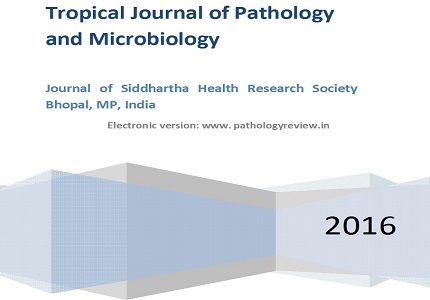Detection of various beta lactamases in gram negative bacteria and their resistance pattern in northern India
Abstract
Background: Resistance to broad spectrum beta lactam antibiotics due to ESBL/AmpC/MBL enzymes is an increasing problem worldwide. Estimation of their prevalence in the area is essential to formulate an effective antimicrobial policy for a particular hospital/area.
Aim: The present study was done to know the prevalence of ESBL/AmpC/MBL in gram negative organisms isolated from clinical samples and their susceptibility pattern in a tertiary care hospital in northern India.
Methods: Total of 160 isolates of gram negative organisms from clinical specimens were screened for the presence of various beta lactamases by standard phenotypic methods and their antibiotic susceptibility pattern to conventionally used antibiotics was determined by disc diffusion method as per CLSI guidelines.
Results: 118 gram negative isolates showing reduced susceptibility to third generation cephalosporin’s were screened for ESBL/ AmpC/ MBL production. Beta lactamase production was seen in 74 out of the 160 gram negative isolates obtained from different samples. ESBL production alone or in combination with AmpC/MBL is seen in 60 isolates. ESBL/ AmpC and ESBL/ MBL coproduction was seen in 9(5.6%) and 3(1.9%) of the isolates respectively. Multi drug resistance was significantly higher in beta lactamase producers than non lactamase producers.
Conclusions: There is need for continuous surveillance in the hospitals for the detection of various beta lactamases or resistant strains. Strict guidelines should be followed for antibiotic therapy so as to reduce burden of antibiotic resistance. Further phenotypic and genotypic studies should be undertaken to know the resistance pattern in bacteria.
Downloads
References
Shoorashetty RM, Nagarathnamma T, Prathibha J. Comparison of the boronic acid disk potentiation test and cefepime-clavulanic acid method for the detection of ESBL among AmpC-producing Enterobacteriaceae. Indian J Med Microbiol. 2011 Jul-Sep;29(3):297-301. doi: 10.4103/0255-0857.83917. [PubMed]
Jacoby GA. AmpC beta-lactamases. Clin Microbiol Rev. 2009 Jan;22(1):161-82, Table of Contents. doi: 10.1128/CMR.00036-08. [PubMed]
Naas T, Cuzon G, Bogaerts P, Glupczynski Y, Nordmann P. Evaluation of a DNA microarray (Check-MDR CT102) for rapid detection of TEM, SHV, and CTX-M extended-spectrum β-lactamases and of KPC, OXA-48, VIM, IMP, and NDM-1 carbapenemases. J Clin Microbiol. 2011 Apr;49(4):1608-13. doi: 10.1128/JCM.02607-10. Epub 2011 Feb 16.
Steinke DT, Seaton RA, Phillips G, Mac-Donald TM, Davey PG. Prior trimethoprim use and trimethoprim-resistant urinary tract infection: a nested case-control study with multivariate analysis for other risk factors. J Antimicrob Chemother 2001;47(6):781-7.doi:10.1093/jac/47.6.781.
Smith RD, Coast J. Antimicrobial resistance: a global response. Bull World Health Organ. 2002;80(2):126-33. [PubMed]
Collee JG, Miles RS, Wan B. Tests for the identification of bacteria. In: Collee JG, Fraser AG, Marmion BP, Simmons A, eds. Mackie and Mc Cartney Practical Medical Microbiology. 14th ed. Edinburgh: Churchill Livingstone; 1996:131-50.
Wayne PA. Clinical and Laboratory Standards Institute. Performance Standards for Antimicrobial Susceptibility Testing; Twentieth Informational Supplement M100-S20; 2010.
Shahid M, Malik A, Agrawal M, Singhal S. Phenotypic detection of extended-spectrum and AmpC beta-lactamases by a new spot-inoculation method and modified three-dimensional extract test: comparison with the conventional three-dimensional extract test. J Antimicrob Chemother. 2004 Sep;54(3):684-7. Epub 2004 Aug 4.
Yong D, Lee K, Yum JH, Shin HB, Rossolini GM, Chong Y. Imipenem-EDTA disk method for differentiation of metallo-beta-lactamase-producing clinical isolates of Pseudomonas spp. and Acinetobacter spp. J Clin Microbiol. 2002 Oct;40(10):3798-801. [PubMed]
Valsan C, Chinnan JP, Sathiavathy KA. Phenotypic detection of ß-lactamases in enterobacreriaceae using a 12disk procedure. J Acad Clin Microbiol 2013;15(1):7-10.doi:10.4103/0972-1282.116090.
Mathur P, Kapil A, Das B, Dhawan B. Prevalence of extended spectrum beta lactamase producing gram negative bacteria in a tertiary care hospital. Indian J Med Res. 2002 Apr;115:153-7.
Subha A, Ananthan S. Extended spectrum β- lactamase (ESBL) mediated resistance to third generation cephalosporins among Klebsiella pneumonia in Chennai. Indian J Microbiol 2002; 20:92-5.
Bhattacharjee A, Anupurba S, Gaur A, Sen MR. Prevalence of inducible AmpC beta-lactamase-producing Pseudomonas aeruginosa in a tertiary care hospital in northern India. Indian J Med Microbiol. 2008 Jan-Mar;26(1):89-90. [PubMed]
Doi Y, Paterson DL. Detection of plasmid-mediated class C beta-lactamases. Int J Infect Dis. 2007 May;11(3):191-7. Epub 2007 Mar 6. [PubMed]
Coudron PE. Inhibitor-based methods for detection of plasmid-mediated AmpC beta-lactamases in Klebsiella spp., Escherichia coli, and Proteus mirabilis. J Clin Microbiol. 2005 Aug;43(8):4163-7. [PubMed]
Singhal S, Mathur T, Khan S, Upadhyay DJ, Chugh S, Gaind R, Rattan A. Evaluation of methods for AmpC beta-lactamase in gram negative clinical isolates from tertiary care hospitals. Indian J Med Microbiol. 2005 Apr;23(2):120-4. [PubMed]
Arora S, Bal M. AmpC beta-lactamase producing bacterial isolates from Kolkata hospital. Indian J Med Res. 2005 Sep;122(3):224-33. [PubMed]
Datta P, Gupta V, Garg S, Chander J. Phenotypic method for differentiation of carbapenemases in Enterobacteriaceae: study from north India. Indian J Pathol Microbiol. 2012 Jul-Sep;55(3):357-60. doi: 10.4103/0377-4929.101744. [PubMed]
Cormican MG, Marshall SA, Jones RN. Detection of extended-spectrum beta-lactamase (ESBL)-producing strains by the Etest ESBL screen. J Clin Microbiol. 1996 Aug;34(8):1880-4. [PubMed]



 OAI - Open Archives Initiative
OAI - Open Archives Initiative


